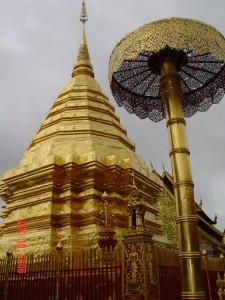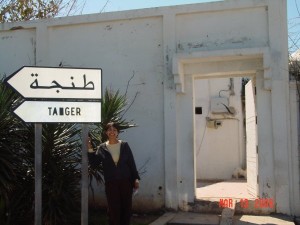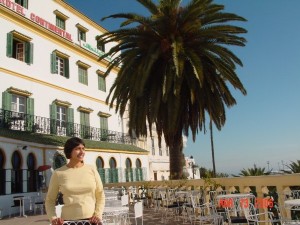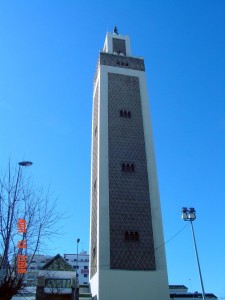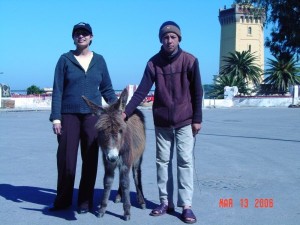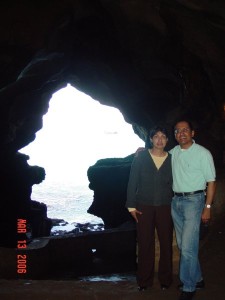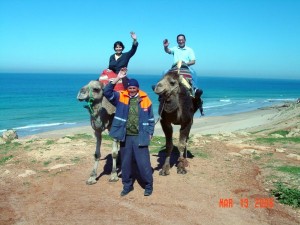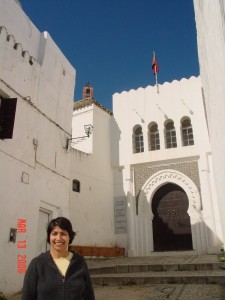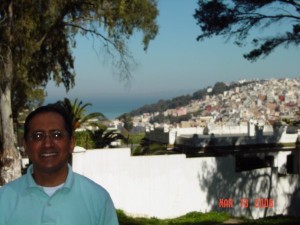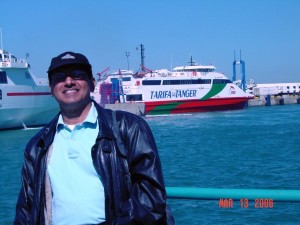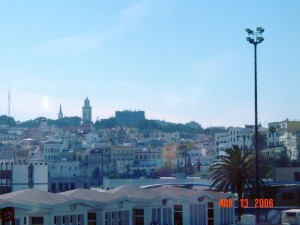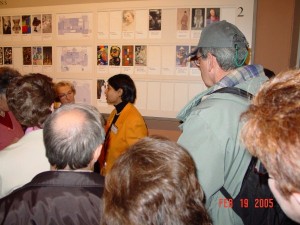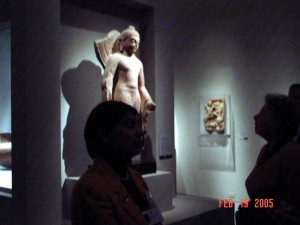Hosted by Llew and Rochelle Almeida

(Gourmet Club Members seated around our dining table at the start of our Thanskgiving on Valentine’s Day Dinner)
Theme:
Though it was February and time to plan a Valentine’s Day menu, our Gourmet Dinner Club members requested that Llew create a menu around his famous signature Indian-style Roasted Marinated Turkey. This was the end result–Thansksgiving on Valentine’s Day!
Bon Appetit!
MENU
Appetizer:
Chopped Liver with Matzo
(Dan and Amy de Lannoy)
Entrée:
Roast Marinated Turkey, Indian Style
(Llew and Rochelle Almeida)
Sides:
Gourmet Green Bean Casserole
with Fried Shallots
(Brett and Mary-Lauren Factora)
Walnut-Sage Potatoes Au Gratin
(Dan and Amy de Lannoy)
Cranberry Pecan Multi-Grain Bread
(Llew and Rochelle Almeida)
Dessert:
Coeur a la Crème with Raspberry Sauce
(Art and Bonnie Britz-Thurnauer)
CHOPPED LIVER WITH MATZO
(From Ina Garten’s Parties Cookbook)
(Makes about 5 cups).
Around the Jewish holidays, Chopped liver is a traditional first course. The Madeira adds a bit of sweetness without you knowing exactly what it is. Be sure not to overprocess this spread; you want it to be chunky. Serve it with pieces of matzo.
Ingredients:
2 pounds chicken livers
1 cup rendered chicken fat (see note)
2 cups medium-diced yellow onions (2 onions)
1/3 cup Madeira wine
4 extra-large hard cooked eggs, peeled and chunked
¼ cup fresh minced parsley
2 tsps fresh thyme leaves
2 teaspoons kosher salt
1 teaspoon freshly ground black pepper
Pinch cayenne pepper
Method:
Drain the livers and saute them in 2 batches in 2 tablespoons of the chicken fat over medium-high heat, turning once, for about 5 minutes, or until just barely pink inside. Don’t overcook the livers or they will be dry. Transfer them to a large bowl.
In the same pan, sauté the onions in 3 tablespoons of the chicken fat over medium-high heat for about 10 minutes, or until browned. Add the Madeira and deglaze the pan, scraping the sides, for about 15 seconds. Pour into the bowl with the livers.
Add the eggs, parsley, thyme, salt, black pepper, cayenne and the remaining chicken fat to the bowl. Toss quickly to combine. Transfer half the mixture to the bowl of a food processor fitted with a steel blade. Pulse 6 to 8 times, until coarsely chopped. Repeat with the remaining mixture. Season to taste and chill. Serve on crackers or matzo.
Note:
To make rendered chicken fat, place the fat in a small covered pan over low heat until the fat melts. Store in the refrigerator. You might want to collect the fat from a couple of chickens that you cook and store it in the freezer. If you’d rather not do that, your local butcher might be able to give you some chicken fat.
ROAST MARINATED TURKEY, INDIAN STYLE
Marinade:
1 quart plain yoghurt
¾ cup lemon juice
1 large onion, peeled and chopped (about 2 cups)
1 small head garlic, about 8 cloves, separated into cloves and peeled
1 (2”) piece ginger root, peeled and sliced
1-2 teaspoons salt
4-5 teaspoons garam masala (ground mixture of cinnamon, cardamom, cumin, nutmeg and black peppercorns—available in Indian stores)
1 teaspoon cayenne pepper
3 teaspoons paprika
2 teaspoons ground coriander
1 teaspoon turmeric
1¼ cups olive oil
10-12 pound turkey
Melted butter
Lemon slices
Method:
To Make Marinade:
Combine all ingredients in blender or food processor until smooth paste forms (Mixture may not be thick). Pour mixture into a very large bowl (large enough to accommodate the entire turkey).
To assemble turkey:
Gash turkey all over at one inch intervals (this allows spices to permeate the meat). Place turkey in bowl, spooning spice mixture all over it. Cover and refrigerate 24 hours.
Preheat oven to 325 degrees. Line roasting pain with heavy-duty aluminum foil. Place turkey in pan, spooning marinade all over it.
Roast for 1¾ hour to 2 hours until leg moves easily when pulled. Cover legs and wing tips with foil if they start to burn.
Brush surface with melted butter. Place turkey on platter. Garnish with lemon slices and serve with mango chutney, if desired. Serves 10 to 15.
GOURMET GREEN BEAN CASSEROLE WITH FRIED SHALLOTS
(from Martha Stewart Living magazine, November 2000)
For this gourmet take on a potluck classic, the casserole is assembled and the shallots are cooked ahead of time. Just before serving, pop the dish under the broiler for about 10 minutes.
Ingredients:
6 tablespoons butter, plus more for dish
1 medium onion, cut into ¼ inch dice
1 red bell pepper, seeded and cut into ½ inch dice
1 pound button mushrooms, stems trimmed and quartered
2 teaspoons coarse salt
½ teaspoon freshly ground black pepper
1½ pounds green beans, trimmed and cut into 2 inch pieces
6 tablespoons all-purpose flour
2 cups milk
Pinch of cayenne pepper
Pinch of grated nutmeg
1 cup grated Parmesan cheese
¼ cup breadcrumbs
¼ cup canola oil
4 shallots, cut crosswise into ¼ inch rings
Method:
Melt 2 tablespoons butter in a large skillet over medium heat. Add onion, and sauté until it begins to soften, about 4 minutes. Add bell pepper and mushrooms, and cook until softened and most of the liquid has evaporated, about 8 minutes. Season with 1teaspoon salt and ¼ teaspoon pepper. Set aside to cool.
Fill a large bowl with ice and water. Set aside. Bring a saucepan of water to a rapid boil. Add beans and cook until bright green and just tender, 4 to 5 minutes. Drain, and plunge into ice bath to stop cooking. When cooled, toss drained beans with mushrooms mixture. Set aside.
Melt the remaining 4 tablespoons butter in a medium saucepan over medium-low heat. Add 4 tablespoons flour, whisk constantly until mixture begins to turn golden brown, about 2 minutes. Pour in milk and continue whisking until mixture has thickened, about 3 minutes. Stir in cayenne, nutmeg, and the remaining teaspoon salt and ¼ teaspoon pepper. Remove from heat and let cool to room temperature, stirring occasionally. Pour over beans and toss to combine.
Butter a 9X13 inch glass or ceramic baking dish. Spread half the green bean mixture over the bottom. Sprinkle half the grated Parmesan and spread the remaining green beans. Combine the remaining Parmesan and the bread crumbs and sprinkle over casserole. Cover with foil and refrigerate until just before serving.
Heat canola oil in a medium skillet over medium-high heat. Toss shallot rings with the remaining 2 tablespoons flour. Fry the shallots in batches, turning frequently, untilk golden brown. Transfer to paper towels to drain. Place in an air tight container and set aside until ready to serve.
Heat broiler, positioning rack about 8 inches from heat. Cook casserole, covered, until mixture is bubbly and heated through, about 10 minutes. Uncover, and cook until top is golden brown, about 30 seconds. Sprinkle fried shallots over top and serve immediately.
WALNUT-SAGE POTATOES AU GRATIN
(from Better Homes and Gardens Magazine, November 2000)
Prep: 30 minutes.
Bake: Standard Oven, 70 minutes
Microwave Oven: 25 Minutes
Ingredients:
6 medium potatoes (2 lbs)
½ cup chopped onion
2 cloves garlic, minced
3 tablespoons walnut oil
3 tablespoons all-purpose flour
½ tsp. salt
¼ tsp. pepper
2½ cups milk
3 tablespoons snipped fresh sage
4 oz. Gruyere cheese, shredded (1 cup)
1/3 cup broken walnut pieces
Fresh sage leaves (optional, for garnish)
Method:
Peel potatoes, if desired, and thinly slice (should have 6 cups). Use a mandolin, if available. Place slices in a colander. Rinse with cool water. Set aside to drain.
For sauce, in a medium saucepan, cook onion and garlic in walnut oil until tender, but not brown. Stir in flour, salt and pepper. Add milk all at once. Cook and stir over medium heat until thickened and bubbly. Remove from heat. Stir in snipped sage.
Grease a 2-quart round casserole (with glass cover). Layer half of the potatoes in the casserole dish. Cover with half the sauce. Sprinkle with half the cheese. Repeat layering with the potatoes and sauce. Cover and chill remaining cheese until needed.
Bake casserole in over at 350 degrees F. for 40 minutes. Uncover, bake 25 minutes more or until potatoes are just tender. Sprinkle remaining cheese and nuts over the top. Bake, uncovered, 5 minutes. Let stand 10 minutes. Top with sage leaves.
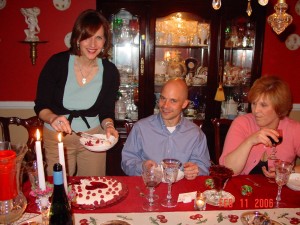
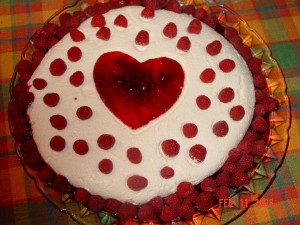
(Bonnie serves up her piece de resistance–Our dessert, the Coeur a la Creme–while Brett and Amy look on appreciatively)
COEUR A LA CREME WITH RASPBERRY SAUCE
(From Ina Garten’s Barefoot in Paris Cookbook)
(Serves 6 to 8)
This amazing dessert was inspired by Ina Garten’s friend Anna Pump in her Loaves and Fishes Cookbook. This is really easy to make and can be prepared days before a party.
To make this dessert, you need a heart shaped dish with perforations. You need to suspend the dish over a bowl to drain overnight. If you don’t have a heart-shaped dish, you can use a 7 inch sieve which will make a round crème, but since this is a Valentine’s Day dinner, I thought it would make sense to use a heart-shaped dish. I have such a dish if anyone wants to borrow mine.
Ingredients:
12 pounces cream cheese, at room temperature (must be room temperature—leave outside refrigerator overnight, if necessary)
1¼ cups confectioners’ sugar
2½ cups cold heavy cream
2 teaspoons pure vanilla extract (use a good quality one)
¼ teaspoon grated lemon zest
Seeds scraped from one vanilla bean
Raspberry Sauce (recipe follows)
1 pint fresh raspberries
Method:
Place the cream cheese and confectioners’ sugar in the bowl of an electric mixer fitted with the paddle attachment and beat on high speed for 2 minutes. Scrape down the beater and bowl with a rubber spatula and change the beater for the whisk attachment. With the beater on low speed, add the heavy cream, vanilla, lemon zest and vanilla seeds and beat on high speed until the mixture is very thick, like whipped cream.
Line a heart-shaped mold with cheesecloth (use 3 layers) so the ends drape over the sides and place it on a plate making sure there is space between the bottom of the mold and the plate for the liquid to drain (Place a few hard, uncooked beans at the bottom to create that draining space, if necessary). Pour the cream mixture into the cheese cloth, fold the ends over the top, and refrigerate overnight.
To serve, discard the liquid, unmold the cream onto a plate (preferably white) and drizzle raspberry sauce all around the base. Serve with raspberries and extra sauce.
Raspberry Sauce:
(Makes 2 cups)
For a sauce, nothing is easier or fresher tasting than this raspberry sauce. Its also great for entertaining because you can make it a day or two in advance. Framboise is a clear raspberry eau-de-vie that you can find at a liquor store.
Ingredients:
1 half-pint fresh raspberries
½ cup sugar
1 cup (12 ounces) seedless raspberry jam (it MUST be seedless)
1 tablespoon framboise liqueur
Method:
Place the raspberries, sugar and ¼ cup water in a small saucepan. Bring to a boil, lower the heat and simmer for 4 minutes. Pour the cooked raspberries, the jam and the framboise into the bowl of a food processor fitted with the steel blade and process until smooth. Chill.
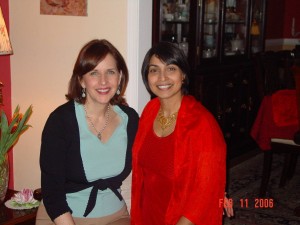
(Bonnie and Rochelle at the end of the evening)
 The Sturms decided to take us to a heurige, a typical Austrian evening of entertainment which originated in the sampling of the first pressings of the year’s vintage. Red and white wines are sampled in-between courses that comprise delicious cheese spreads, cold meats, roasts and pickles, salads and the most delectable bread you can imagine. Music and festivity characterize an Austrian heurige and we enjoyed two of these—one at Mayer am Pfarrplatz, in a historic inn in Nussdorf in which the composer Beethoven once lived and one in a charming Baden courtyard. Ronni also gave us a driving tour of Vienna by night which allowed us to see the city’s major monuments all beautifully floodlit and presenting a completely different facet of themselves.
The Sturms decided to take us to a heurige, a typical Austrian evening of entertainment which originated in the sampling of the first pressings of the year’s vintage. Red and white wines are sampled in-between courses that comprise delicious cheese spreads, cold meats, roasts and pickles, salads and the most delectable bread you can imagine. Music and festivity characterize an Austrian heurige and we enjoyed two of these—one at Mayer am Pfarrplatz, in a historic inn in Nussdorf in which the composer Beethoven once lived and one in a charming Baden courtyard. Ronni also gave us a driving tour of Vienna by night which allowed us to see the city’s major monuments all beautifully floodlit and presenting a completely different facet of themselves.




